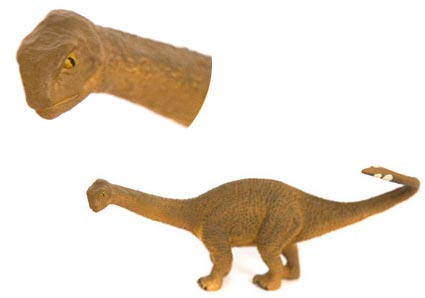Shunosaurus – A Chinese Dinosaur with a Club on its Tail
The city of Zigong in Sichuan province in south-west China has a population of several million. The city was once one of the wealthiest in the Orient as it was the centre of the region’s salt trade, and although it has a rich legacy of human history, it is also at the centre of one of the most important palaeontological sites in the world.
Much of the exposed strata in the area dates back to the mid Jurassic, with sediments dating from around 170 million years ago to about 150 million years ago and a number of dinosaur fossils have been found in the area. In Jurassic times, the region was a lush lowland with rivers slowly meandering across it and wide, scattered shallow lakes. The forests were dominated by tall conifers and there were groves of cycads and vast amounts of ferns. The climate and the environment seemed to have remained remarkable unchanged for millions of years, rivers deposited mud and silts and the remains of many different types of animals and plants were preserved in the soft mud. Dead dinosaurs were entombed in the mud and their skeletons preserved without being broken up so a number of fully articulated specimens have been excavated, permitting scientists to gain a great deal of information on the sauropods that dominated the ecosystem at the time.
Shunosaurus
The most numerous fossils of an animal classes as a “megafauna” creature have been identified as Shunosaurus, sometimes also known as Shuosaurus. Shunosaurus was named after the term “Shu” which is the old Chinese name for this ancient province. Shunosaurus is pronounced “Shu-no-sore-us”, it was a relatively small sauropod when compared to the better known and later long-necked sauropods from the Morrison Formation of the USA, measuring around 9-10 metres in length. The most remarkable feature of Shunosaurus was the spiked club on the end of its tail. When the first fossils of this animal were found it was thought that the tail structure was a deformity in the specimen, but as more fossils were found this club-tail was confirmed as an anatomical feature. The relatively stiff tail had a large round club at the end, with two pairs of spikes.
An Illustration of Shunosaurus

Picture credit: Everything Dinosaur
When swung from side to side this would have made a very formidable weapon. Shunosaurus would have been very capable of defending itself from the large meat-eating theropods such as Gasosaurus that shared the habitat with this peaceful herbivore.
Many model manufacturers base their production in China, it is refreshing to see a model manufacturer design a Chinese dinosaur model. American and European dinosaurs normally dominate dinosaur toy and model ranges but the diversity and importance of Chinese dinosaurs has at least been recognised by one designer and a dinosaur model of Shunosaurus has recently been added to the Everything Dinosaur – Dinosaur collection section of our website.
A Picture of the Shunosaurus Model
Picture credit: Everything Dinosaur
To view the model of Shunosaurus and other long-necked dinosaur models: Dinosaur Toys and Prehistoric Animal Models.
As well as the club-like tail, Shunosaurus had another strange feature, perhaps not so obvious in the model until it is compared with other dinosaur toys and models of long-necked dinosaurs. Shunosaurus for a sauropod, had a relatively short neck. As sauropods evolved from their more primitive herbivorous ancestors, the number of vertebrae in the neck increase. This probably helped them to adapt to a lifestyle of feeding on taller and taller trees. Shunosaurus however, bucks this trend, so it may have fed on the understorey, on shorter shrubs and bushes – perhaps specialising in feeding on types of plants such as cycads and bennettitales. This may have been an important evolutionary adaptation to allowed Shunosaurus to co-exist with a large number of different types of sauropod in the Sichuan province.







Leave A Comment